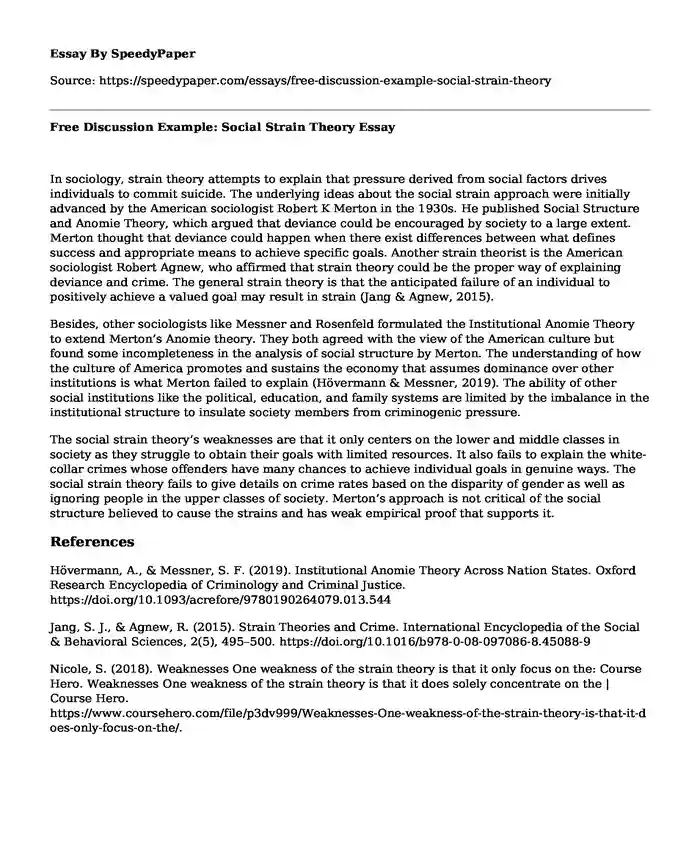
| Type of paper: | Essay |
| Categories: | Sociology |
| Pages: | 2 |
| Wordcount: | 429 words |
In sociology, strain theory attempts to explain that pressure derived from social factors drives individuals to commit suicide. The underlying ideas about the social strain approach were initially advanced by the American sociologist Robert K Merton in the 1930s. He published Social Structure and Anomie Theory, which argued that deviance could be encouraged by society to a large extent. Merton thought that deviance could happen when there exist differences between what defines success and appropriate means to achieve specific goals. Another strain theorist is the American sociologist Robert Agnew, who affirmed that strain theory could be the proper way of explaining deviance and crime. The general strain theory is that the anticipated failure of an individual to positively achieve a valued goal may result in strain (Jang & Agnew, 2015).
Besides, other sociologists like Messner and Rosenfeld formulated the Institutional Anomie Theory to extend Merton’s Anomie theory. They both agreed with the view of the American culture but found some incompleteness in the analysis of social structure by Merton. The understanding of how the culture of America promotes and sustains the economy that assumes dominance over other institutions is what Merton failed to explain (Hövermann & Messner, 2019). The ability of other social institutions like the political, education, and family systems are limited by the imbalance in the institutional structure to insulate society members from criminogenic pressure.
The social strain theory’s weaknesses are that it only centers on the lower and middle classes in society as they struggle to obtain their goals with limited resources. It also fails to explain the white-collar crimes whose offenders have many chances to achieve individual goals in genuine ways. The social strain theory fails to give details on crime rates based on the disparity of gender as well as ignoring people in the upper classes of society. Merton’s approach is not critical of the social structure believed to cause the strains and has weak empirical proof that supports it.
References
Hövermann, A., & Messner, S. F. (2019). Institutional Anomie Theory Across Nation States. Oxford Research Encyclopedia of Criminology and Criminal Justice. https://doi.org/10.1093/acrefore/9780190264079.013.544
Jang, S. J., & Agnew, R. (2015). Strain Theories and Crime. International Encyclopedia of the Social & Behavioral Sciences, 2(5), 495–500. https://doi.org/10.1016/b978-0-08-097086-8.45088-9
Nicole, S. (2018). Weaknesses One weakness of the strain theory is that it only focus on the: Course Hero. Weaknesses One weakness of the strain theory is that it does solely concentrate on the | Course Hero. https://www.coursehero.com/file/p3dv999/Weaknesses-One-weakness-of-the-strain-theory-is-that-it-does-only-focus-on-the/.
Cite this page
Free Discussion Example: Social Strain Theory. (2023, Dec 08). Retrieved from https://speedypaper.com/essays/free-discussion-example-social-strain-theory
Request Removal
If you are the original author of this essay and no longer wish to have it published on the SpeedyPaper website, please click below to request its removal:
- Ways of Punishing Criminals - Criminal Justice Essay Example
- Law Essay Example: Juvenile Incarceration
- Violence, Sex, and Dreams - Free Essay with the Article Analysis
- Essay Example: Unemployment as a Social Issue Affecting the Quality of Life in Jamaica
- Free Essay - Corporate Social Responsibility
- Essay Sample on Minimum Federal Wage
- Free Essay. Education Plan for Covid-19
Popular categories




